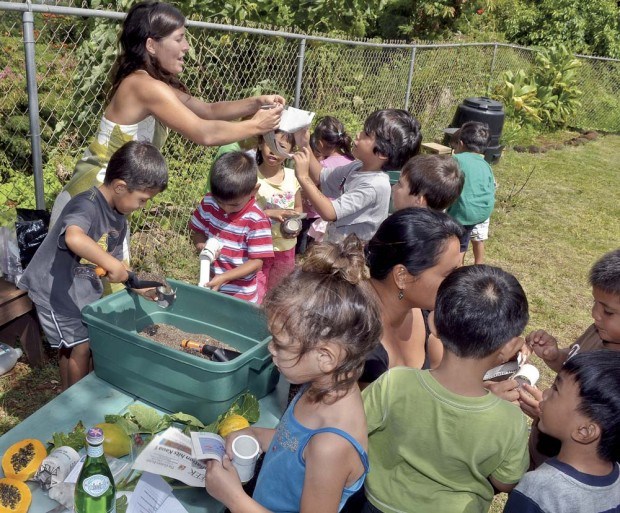LIHU‘E — Healthy food and community involvement are the goals that the Farm to Preschool program is hoping to accomplish when it launches this fall at 18 preschools on Kaua‘i, said Tiana Kamen of Malama Kaua‘i. Kamen was joined by
LIHU‘E — Healthy food and community involvement are the goals that the Farm to Preschool program is hoping to accomplish when it launches this fall at 18 preschools on Kaua‘i, said Tiana Kamen of Malama Kaua‘i.
Kamen was joined by Laura Kawamura in hosting a preview of the program for Paul Hunting, the Community Intervention Team Leader and Senior Project Officer of the Community Putting Prevention to Work Unit. He was visiting Kaua‘i for an update on CPPW projects before heading to Maui.
Thomas Noyes of the Kaua‘i Path said the Farm to Preschool program is one of the new CPPW projects being funded through a grant from the Centers for Disease Control and Prevention.
Demonstrating the various facets of the program, Kamen and Kawamura had ‘Ae Kamali‘i Preschool students assuming roles of food scientist and farmers, getting hands-on experience with a readily available local fruit, papaya.
“Good health means eating foods from the colors of the rainbow,” Kamen said, asking the color of a ripe papaya.
Meanwhile, Kawamura had her students sampling freshly cut papaya and rating its taste using a taste rating sheet based on different levels of smiling faces and a sticky dot indicating each taster’s preference.
She went one step further, distributing a wedge of lime which was squeezed onto the papaya and then repeating the taste test.
The multifaceted approach to the papaya, not one of the curriculum items in the Farm to Preschool program, carried over to the garden when the scientists turned into farmers, identifying the fruit and finishing with seeds to grow their own papaya.
Kamen said generally under the Farm to Preschool program, a product of the month is selected and based on the different curriculum, students work with their teachers to identify it, learn about its nutritional qualities and even plant the product, harvesting and enjoying it as part of their school meal or snack.
Tiny hands worked with strips of newspaper as Kamen led the young gardeners in creating planting pots which were filled with soil, laced with a few seeds from the papaya she cut to show the students the various parts of the fruit.
Once completed, Kamen led the students to cover the seeds with a “blanket” of soil and say “good night” while the seeds and moisture did the rest.
“We’ve had requests from schools on other islands asking about this project,” Kamen said. “But we’re going to start with the schools on Kaua‘i, including all of the Head Start schools.”
Both Kawamura and Kamen agreed on the fact that the program teaches students a lot more than just eating healthy.
“The goal is to get the community involved and become excited about starting their own gardens,” Kawamura said. “The idea of the planting pots came from something I found and, after getting help from Lincoln Ching, works because it’s not just about growing; it’s also recycling.”
Noyes said the Farm to Preschool program falls under the Get Fit Kaua‘i program headed by Bev Brody, who was busy helping Kawamura distribute fruit and even having time to show Hunting a monarch butterfly egg on a crown flower plant growing in the ‘Ae Kamali‘i garden.
Some of the projects accomplished under the CPPW program include the multi-use bicycle and walking path, supporting school policies which ensure school cafeterias and vending machines offer healthy food and beverage options, develop remote school drop-off sites to encourage students and staff to walk longer distances while reducing traffic at school entrances, and developing sustainable community gardens targeting underserved populations.


